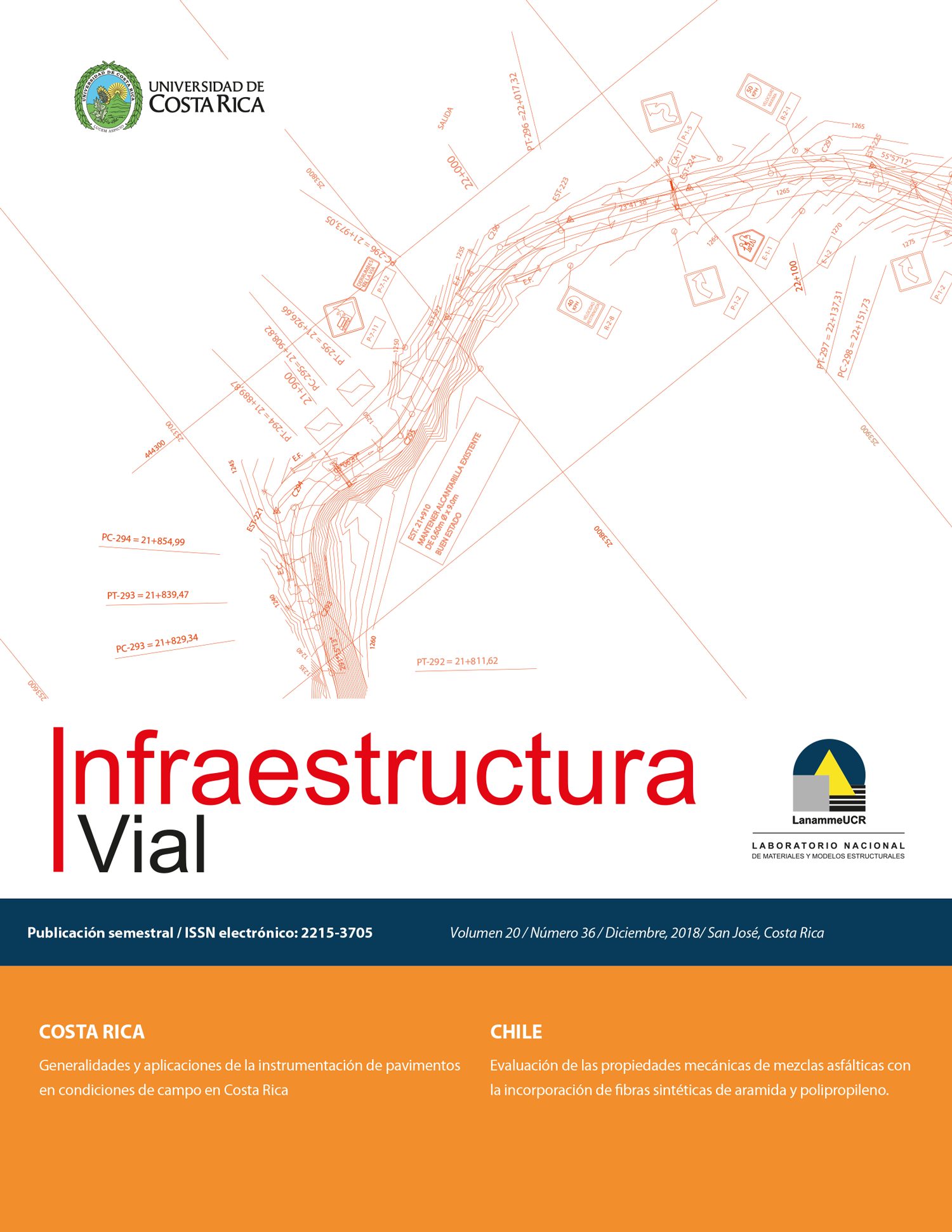Resumen
Las carreteras están expuestas a agentes externos, como la lluvia, radiación solar, el aumento del flujo vehicular, entre otras, que contribuyen a generar deterioros en los pavimentos asfálticos. Esto hace necesaria la búsqueda nuevas tecnologías capaces de dar solución a estas condiciones externas. En la actualidad, la utilización de asfaltos modificados con polímeros es una de las alternativas más utilizadas, puesto que le otorga una mayor durabilidad a la estructura de pavimento. Sin embargo, la literatura indica que existen otras técnicas lo suficientemente competitivas que permiten la obtención de buenos resultados, como el uso de fibras sintéticas. En este contexto, la presente investigación tiene como objetivo principal evaluar la influencia de la incorporación de fibras sintéticas de aramida y polipropileno en las propiedades mecánicas de las mezclas asfálticas. Para ello, se realizó un diseño de una mezcla IV-A-12 (comúnmente utilizada en Chile) con un ligante tipo CA-2(de acuerdo a las especificaciones chilenas) con incorporación de diferentes porcentajes de fibras. Las propiedades mecánicas de las mezclas asfálticas modificadas fueron comparadas con una mezcla de referencia. A través de una fase experimental realizada, se evaluaron las propiedades de fisuración térmica, daño por humedad y el comportamiento frente a las deformaciones permanentes. Los resultados muestran que la adición de las fibras sintéticas de aramida y polipropileno reducen el daño por humedad y el ahuellamiento, mejorando también la respuesta frente a la fisuración térmica.
Citas
Abiola, O. S., Kupolati, W. K., Sadiku, E. R., & Ndambuki, J. M. (2014). Utilisation of natural fibre as modifier in bituminous mixes: A review. Construction and Building Materials, 54, 305–312. https://doi.org/10.1016/j.conbuildmat.2013.12.037
Abtahi, S. M., Sheikhzadeh, M., & Hejazi, S. M. (2010). Fiber-reinforced asphalt-concrete - A review. Construction and Building Materials, 24(6), 871–877. https://doi.org/10.1016/j.conbuildmat.2009.11.009
Afonso, M. L., Dinis-Almeida, M., & Fael, C. S. (2017). Study of the porous asphalt performance with cellulosic fibres. Construction and Building Materials, 135, 104–111. https://doi.org/10.1016/j.conbuildmat.2016.12.222
Ahmad, A., & Kareem, Y. (2015). Fatigue Behavior of Polypropylene Fiber Reinforced Bituminous Concrete Mix, 4(02), 449–453.
Al-Hadidy, A. I., & Yi-qiu, T. (2009). Effect of polyethylene on life of flexible pavements. Construction and Building Materials, 23(3), 1456–1464. https://doi.org/10.1016/j.conbuildmat.2008.07.004
Aliha, M. R. M., Razmi, A., & Mansourian, A. (2017). The influence of natural and synthetic fibers on low temperature mixed mode I + II fracture behavior of warm mix asphalt (WMA) materials. Engineering Fracture Mechanics, 182, 322–336. https://doi.org/10.1016/j.engfracmech.2017.06.003
Chen, H., Xu, Q., Chen, S., & Zhang, Z. (2009). Evaluation and design of fiber-reinforced asphalt mixtures. Materials and Design, 30(7), 2595–2603. https://doi.org/10.1016/j.matdes.2008.09.030
Haddadi, S., Ghorbel, E., & Laradi, N. (2008). Effects of the manufacturing process on the performances of the bituminous binders modified with EVA. Construction and Building Materials, 22(6), 1212–1219. https://doi.org/10.1016/j.conbuildmat.2007.01.028
Huang, H., & White, T. D. (1996). Dynamic Properties of Fiber-Modified. Transportation Research Record: Journal of the Transportation Research Board, 98–104. Retrieved from https://doi.org/10.3141/1545-13
ITEM 400 HS. (1998). Standard specification for asphalt concrete - high stress using polypropylene fibers Using polypropylene Fibers. Flexible Pavements Inc.
Kaloush, K. E., Biligiri, K. P., Zeiada, W. A., Rodezno, M. C., & Reed, J. X. (2010). Evaluation of Fiber-Reinforced Asphalt Mixtures Using Advanced Material Characterization Tests. Journal of Testing and Evaluation, 38(4), 102442. https://doi.org/10.1520/JTE102442
Kaloush, K. E., Zeiada, W. A., Biligiri, K. P., Rodezno, M. C., & Reed, J. X. (2010). Evaluation of Fiber-Reinforced Asphalt Mixtures Using Advanced Material Characterization Tests. Journal of Testing and Evaluation, 38(4), 102442. https://doi.org/10.1520/JTE102442
Kutay, M. E., Gibson, N., & Youtcheff, J. (2008). Kutay, M. E., Gibson, N., & Youtcheff, J. In Conventional and viscoelastic continuum damage (VECD) - Based fatigue analysis of polymer modified asphalt pavements.
Mello, L. G., Kaloush, K. E., & Biligiri, K. P. (2008). Evaluation of Fiber Reinforcement in Hot Mix Asphalt Using Advanced Material Characterization Tests. In The First Pan American Geosynthetics Conference & Exhibition 2-5 March 2008, Cancun, Mexico(pp. 0–7).
Pamulapati, Y., Elseifi, M. A., Cooper, S. B., Mohammad, L. N., & Elbagalati, O. (2017). Evaluation of self-healing of asphalt concrete through induction heating and metallic fibers. Construction and Building Materials, 146, 66–75. https://doi.org/10.1016/j.conbuildmat.2017.04.064
Reyes, O ., Camacho, J. & Mejia, M. (2017). Resistencia mecánica y dinámica de mezclas asfálticas adicionadas con fibras sintéticas. Congreso Ibero-Latinoamericano Del Asfalto CILA XX.
Valdés, G., Pérez-Jiménez, F., & Botella, R. (2009). Ensayo Fénix, una Nueva Metodología para Medir la Resistencia a la Fisuración en Mezclas Asfálticas. Revista de La Construccion, 8(1), 114–125.
Valdés V, G. A., Pérez-Jiménez, F. E., & Botella N, R. (2013). Nuevo procedimiento para evaluar el comportamiento a fatiga en pavimentos asfálticos a través del ensayo Fénix New procedure to assess the fatigue behavior in asphalt pavements by Fénix test. Ingeniare. Revista Chilena de Ingeniería, 21(3), 362–371. https://doi.org/10.4067/S0718-33052013000300006
Wu, S., Ye, Q., & Li, N. (2008). Investigation of rheological and fatigue properties of asphalt mixtures containing polyester fibers. Construction and Building Materials, 22(10), 2111–2115. https://doi.org/10.1016/j.conbuildmat.2007.07.018
Wu, S., Ye, Q., Li, N., & Yue, H. (2007). Effects of fibers on the dynamic properties of asphalt mixtures. Journal of Wuhan University of Technology-Mater. Sci. Ed., 22(4), 733–736. https://doi.org/10.1007/s11595-006-4733-3
Xu, Q., Chen, H., & Prozzi, J. A. (2010). Performance of fiber reinforced asphalt concrete under environmental temperature and water effects. Construction and Building Materials, 24(10), 2003–2010. https://doi.org/10.1016/j.conbuildmat.2010.03.012
Yang, J. M., Kim, J. K., & Yoo, D. Y. (2016). Effects of amorphous metallic fibers on the properties of asphalt concrete. Construction and Building Materials, 128, 176–184. https://doi.org/10.1016/j.conbuildmat.2016.10.082
Yoo, P. J., & Kim, T. W. (2015). Strengthening of hot-mix asphalt mixtures reinforced by polypropylene-impregnated multifilament glass fibres and scraps. Construction and Building Materials, 75, 415–420. https://doi.org/10.1016/j.conbuildmat.2014.11.009


